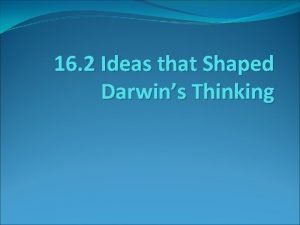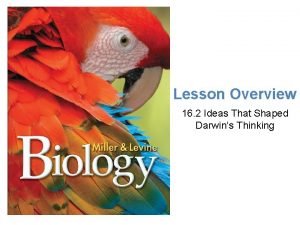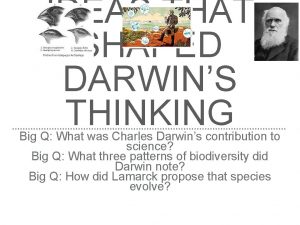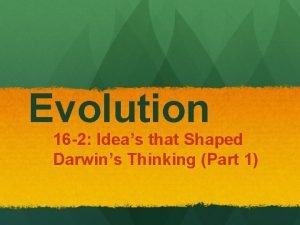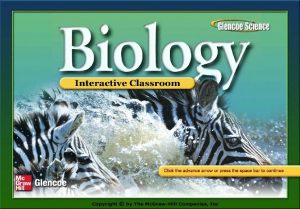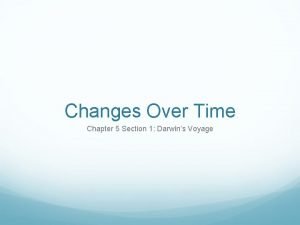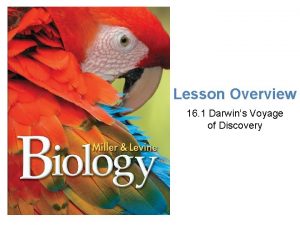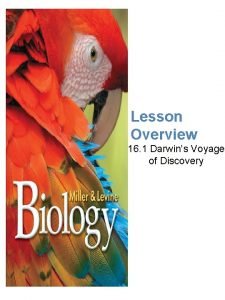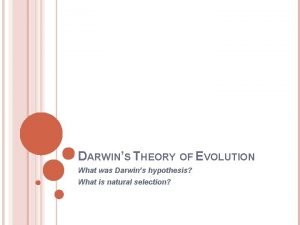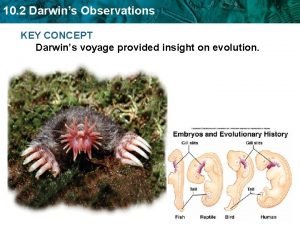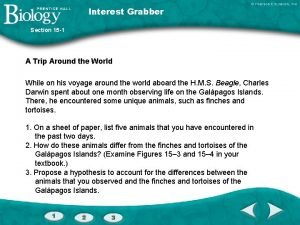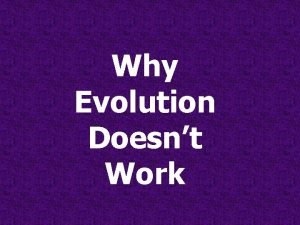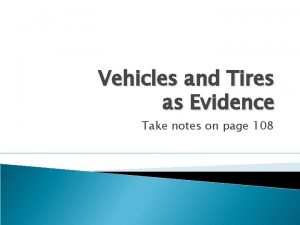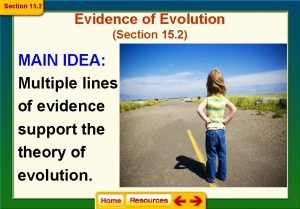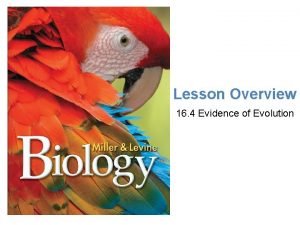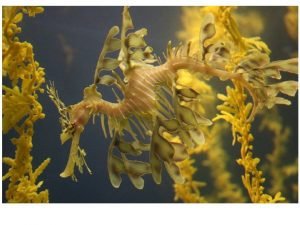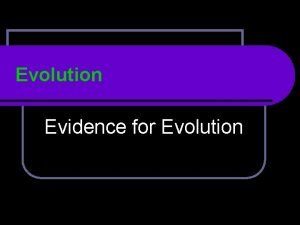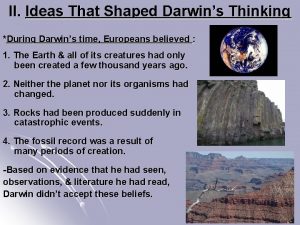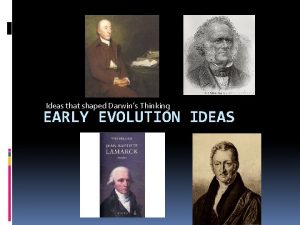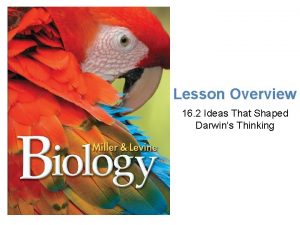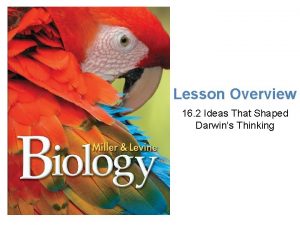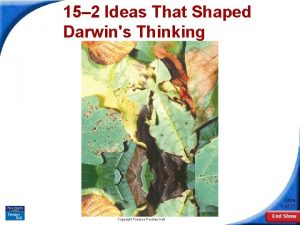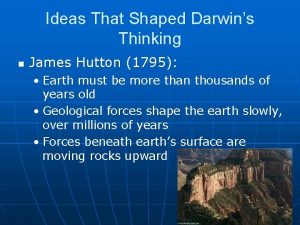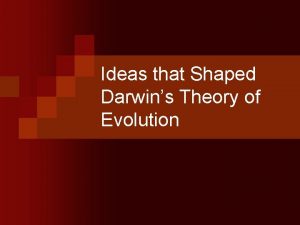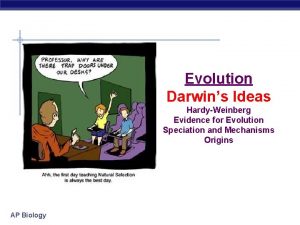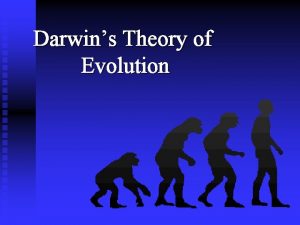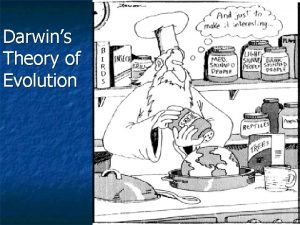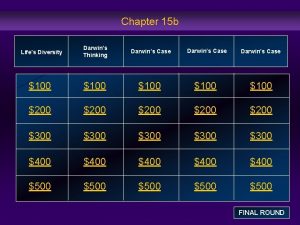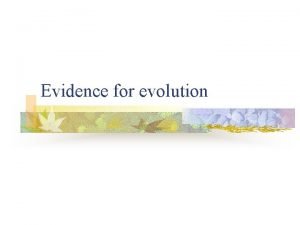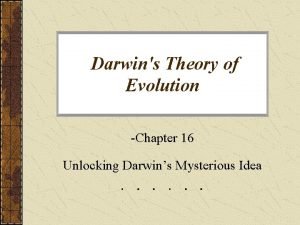Evidence for Evolution Ideas that shaped Darwins thinking




























- Slides: 28

Evidence for Evolution Ideas that shaped Darwin’s thinking

The story of the Soapberry bug and the antibiotic resistant bacteria.

Natural selection is a process of editing, not a creative mechanism. A drug/fruit does not create a different species it selects for specific traits in a population that allow it to survive it that specific environment.

Ideas that shaped Darwin’s thinking Prior to Darwin’s Theory of Evolution there were 4 scientists that had their own ideas and theory’s 1. Hutton 2. Lyell 3. Lamarck 4. Malthus The Rock Boys!! The Math guy!

James Hutton Helped scientists understand that Earth is many millions of years old Processes that changed the Earth in the past are the same processes that operate in the present

Charles Lyell In Lyell’s book: Principles of Geology Rock Cycle: Volcanoes and Earthquakes Erosion continues to carve out canyons.

Uniformitarianism Uniformitarianism: the natural laws and processes that operate in the universe now, have always operated in the past. Uniformitarianism How do you pronounce that? ?

Jean-Baptiste Lamarck Use or disuse of organs, organisms acquired or lost certain traits during their lifetime. Traits could then be passed on to their offspring.

Thomas Robert Malthus reasoned that if the human population continued to grow unchecked, sooner or later there would be insufficient living space and food for everyone. Supporting Darwin’s thought that only those who have the best traits for the environment will find the space, food, etc.

Thomas Robert Malthus He theorized that there was a “carrying capacity” in every habitat/ environment Populations will naturally get checked by famine, disease etc.

Darwin’s Theory of Evolution 1. Change over time, common ancestor Pre-existing variation 2. Variation within a population or species Everyone is just a little different 3. Natural selection Adaptations Survival of the fittest

Darwin’s Evidences 1. Fossil Record Yes, I can support it! 2. Biogeography: Geographical Distribution 3. Vestigial Organs 4. Similarities in Structure Homologous Structures 5. Similarities in Early development Embryology

1. Fossil Record Preserved remains or markings left by organisms that lived in the past are called fossils.

Comparing fossils to present day organisms not only show changes but also what species have become extinct. Position of fossils can reveal their age. Younger Older


2. BIogeography Organisms in different parts of the world shared similarities (continental drift) Ex. Endemic species

3. Vestigial Organs of many animals are so reduced in size that they are just vestiges, or traces, of homologous organs in other species I have a pelvis!!!

4. Similarities in structures Homologous structure: same basic structure but different function Analogous structure: same basic function, but do not have the same basic structure

Homologous structures: similar structures but have different function Derived from a common ancestor; different environment conditions Ex. Forelimb

Analogous structures: similar function but not similar in structure Not derived from a common ancestor; same environmental conditions Ex. A butterfly wing and a bird wing

5. Similarities in Early development Common pattern in the development In their early stages, chickens, turtles, and rats look similar, providing evidence that they shared a common ancestor Posterior tail, pharyngeal pouches

Lets Play a Game Adopt an Embryo! Select one embryo to adopt as your own!!

Class Activity Adopt an Embryo! 1 2 3 4 5 6 7 8

Adopt and Embryo Stage 2 1 2 3 4 5 6 7 8

Adopt an Embryo Stage 3

Darwin’s Evidences 1. Fossil Record Yes, I can support it! 2. Biogeography: Geographical Distribution 3. Vestigial Organs 4. Similarities in Structure Homologous Structures 5. Similarities in Early development Embryology

Evolution…. ”just a theory”…. Life has changed over time, documented and supported

Homologous vs. Analogous Activity HOMOLOGOUS STRUCTURE Same Structure different function ANALOGOUS STRUCTURE Same function different structure Instructions: 1. Read 2. Define 3. Color 4. Chart 5. Answer Questions
 Section 15–2 ideas that shaped darwin’s thinking
Section 15–2 ideas that shaped darwin’s thinking 15-2 ideas that shaped darwin's thinking
15-2 ideas that shaped darwin's thinking Lesson 2 ideas that shaped darwins thinking
Lesson 2 ideas that shaped darwins thinking Section 15-2 ideas that shaped answer key
Section 15-2 ideas that shaped answer key Chapter 17 darwin's theory of evolution
Chapter 17 darwin's theory of evolution 16.2 ideas that shaped darwin's thinking
16.2 ideas that shaped darwin's thinking Phân độ lown ngoại tâm thu
Phân độ lown ngoại tâm thu Block xoang nhĩ là gì
Block xoang nhĩ là gì Thơ thất ngôn tứ tuyệt đường luật
Thơ thất ngôn tứ tuyệt đường luật Thơ thất ngôn tứ tuyệt đường luật
Thơ thất ngôn tứ tuyệt đường luật Walmart thất bại ở nhật
Walmart thất bại ở nhật Tìm vết của đường thẳng
Tìm vết của đường thẳng Hãy nói thật ít để làm được nhiều
Hãy nói thật ít để làm được nhiều Tôn thất thuyết là ai
Tôn thất thuyết là ai Gây tê cơ vuông thắt lưng
Gây tê cơ vuông thắt lưng Sau thất bại ở hồ điển triệt
Sau thất bại ở hồ điển triệt Chapter 15 section 1 darwins theory of natural selection
Chapter 15 section 1 darwins theory of natural selection Adaptation
Adaptation Species that vary locally
Species that vary locally Darwin's voyage of discovery
Darwin's voyage of discovery Darwin's hypothesis
Darwin's hypothesis Darwins observations
Darwins observations Section 15-2 ideas that shaped answer key
Section 15-2 ideas that shaped answer key Evidence of evolution
Evidence of evolution Evidence for evolution doodle notes
Evidence for evolution doodle notes Section 15-2 evidence of evolution answer key
Section 15-2 evidence of evolution answer key Basilosarus
Basilosarus Molecular biology evidence of evolution
Molecular biology evidence of evolution Evidence of evolution
Evidence of evolution

